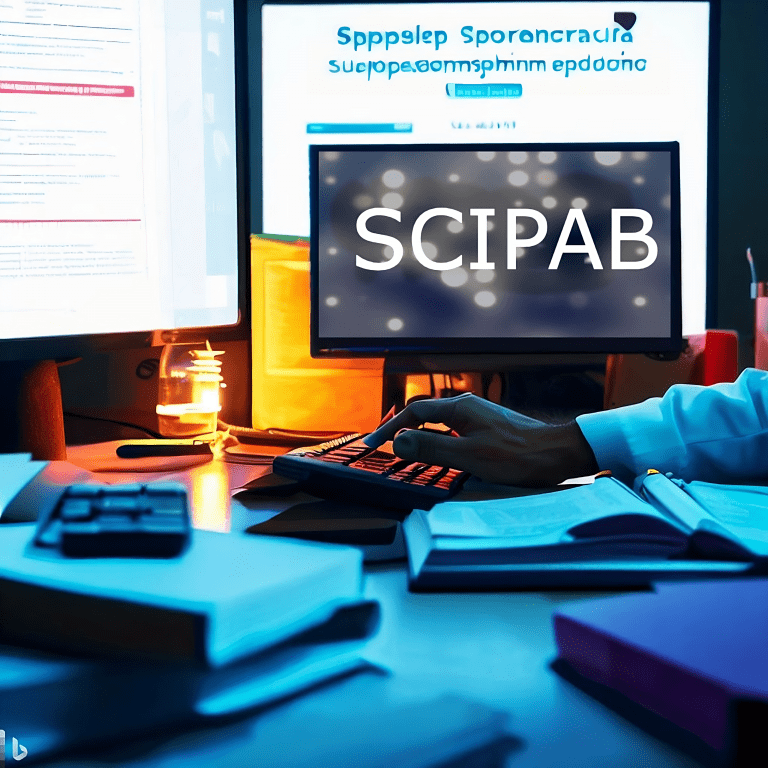Introduction to Scipab Writing Style
Scipab is an acronym for “scientific paragraph,” and it refers to a writing style that aims to make scientific information more accessible to non-experts. The Scipab writing style prioritizes simplicity, clarity, and readability while still maintaining the integrity of the scientific content. In this article, we will explore the key features of the Scipab writing style and discuss how it can be employed effectively in various contexts.
In recent years, there has been a growing demand for accessible scientific communication. As more people become interested in scientific topics, there is a need for writers who can present complex information in an easily digestible format. The Scipab writing style answers this call by offering a structured approach to creating clear and engaging scientific content.
One of the core tenets of the Scipab writing style is making scientific information accessible to a wider audience. This is important for several reasons. First, it helps bridge the gap between scientists and non-experts, fostering a greater understanding of scientific concepts among the general public. This increased awareness can lead to better-informed decision-making in areas such as public policy, healthcare, and environmental conservation.
Secondly, by making science more approachable, we can inspire future generations of scientists and researchers. Students who might have been intimidated by dense scientific literature will find Scipab-style articles easier to comprehend, sparking their curiosity and encouraging them to pursue further studies in science-related fields.
Editing an article to use the scipab style
To edit an article using the SCIPAB style, you can follow these steps:
- Situation: Clearly describe the current situation or problem that the article addresses. This sets the context for the reader.
- Complication: Identify any complications or challenges related to the situation. This helps to highlight the complexity of the issue.
- Implication: Discuss the implications or consequences of the situation and complications. This helps the reader understand the significance of the topic.
- Position: Clearly state your position or recommendation regarding the situation. This is where you present your main argument or point of view.
- Action: Outline the specific actions or steps that should be taken to address the situation. This provides a practical and actionable plan for the reader.
- Benefit: Explain the benefits or positive outcomes that can be achieved by implementing the recommended actions. This helps to motivate and persuade the reader.
By following these steps, you can organize your content into a persuasive narrative flow that resonates with your audience and drives optimal outcomes
Examples of applying scipab style
The table below shows examples of applying the scipab style to various paragraphs.
| Original Text | Scipab Style |
|---|---|
| Global warming is an alarming issue faced by our planet. The rapid increase in temperature has led to the melting of polar ice caps and the rise in sea levels. This phenomenon poses a threat to coastal cities, causing damage to infrastructure and displacing millions of people. | Issue: Global warming. Problem: Rapid increase in temperature, melting polar ice caps, rising sea levels. Consequence: Threat to coastal cities, damage to infrastructure, displacement of millions. |
| The human brain is a complex organ that controls our thoughts, emotions, and actions. It is made up of billions of neurons that communicate with each other through electrical and chemical signals. Understanding how these processes work can help us better understand human behavior and develop treatments for neurological disorders. | Subject: Human brain. Description: Complex organ controlling thoughts, emotions, actions; billions of neurons communicating via electrical & chemical signals. Purpose: Understand human behavior, develop treatments for neurological disorders. |
| Artificial intelligence (AI) refers to the development of computer systems that can perform tasks that would typically require human intelligence. These tasks include learning, reasoning, problem-solving, perception, and natural language understanding. AI has the potential to revolutionize industries and improve our daily lives significantly. | Topic: Artificial intelligence (AI). Definition: Computer systems performing tasks requiring human intelligence; learning, reasoning, problem-solving, perception, natural language understanding. Impact: Revolutionize industries, improve daily lives. |
| Renewable energy sources like solar power and wind energy are growing in popularity as alternatives to fossil fuels because they produce little or no pollution and do not contribute to climate change. Governments and businesses worldwide are investing in clean energy technologies to build a sustainable future for our planet. | Focus: Renewable energy sources (solar power, wind energy). Reason: Alternatives to fossil fuels; low/no pollution; no contribution to climate change. Action: Government & business investment in clean energy technologies for a sustainable future. |
| Mental health affects every aspect of our lives, from how we think and feel to how we cope with stress and interact with others. Promoting mental well-being and providing support for those who struggle with mental health issues are critical to building a healthier society for everyone. | Subject: Mental health. Importance: Affects thoughts, feelings, stress coping, social interactions. Goal: Promote mental well-being; provide support for those struggling with mental health issues; build healthier society for all. |
Balancing Key Factors in Scipab Writing
Simplicity and Accuracy
A primary challenge in employing the Scipab writing style is finding the right balance between simplicity and accuracy. Writers must ensure that they do not sacrifice essential details or misrepresent information for the sake of brevity or ease of understanding. To achieve this balance, it is crucial to identify the most important points within a given topic and focus on conveying those clearly without oversimplifying them.
We also need to be mindful of our word choices when using the Scipab writing style. It is essential to use familiar language while still retaining technical accuracy. This may involve substituting complex terminology with more straightforward synonyms or providing brief explanations for specialized terms when necessary.
Readability vs. Depth of Information
Another critical aspect of mastering the Scipab writing style involves finding the sweet spot between readability and depth of information. Readers should be able to grasp the main ideas quickly without feeling overwhelmed by excessive detail or jargon. On the other hand, writers must ensure that they provide enough context so that readers can appreciate the relevance and significance of the presented information.
To find this balance, it can be helpful for writers to keep their target audience in mind when crafting their content. Knowing who you are writing for will help you determine how much background information needs to be provided and how complex your language should be while still maintaining readability.
Active vs. Passive Voice
Traditionally, scientific writing has relied heavily on passive voice constructions; however, many experts now recommend using active voice whenever possible because it contributes to clearer, more engaging prose. In most cases, using active voice makes sentences easier to understand because it emphasizes who or what is responsible for an action.
However, there may still be instances where using passive voice is appropriate in scientific contexts – such as when emphasizing a particular result or when describing procedures where passive voice adds clarity or precision. Ultimately, choosing whether active or passive voice should be employed depends on which option best serves clarity and reader comprehension within each specific context.
Overcoming Challenges in Scipab Writing Approaches
Preserving Scientific Integrity
One of the primary challenges we face in scipab writing is preserving the scientific integrity of our work. As writers, it is essential to ensure that we do not compromise on the accuracy or validity of the information presented, even as we strive to make it more accessible. To overcome this challenge, we must be diligent in our research and fact-checking processes, sourcing information only from reputable sources.
Moreover, we should always be transparent about the methodology and limitations of the studies we discuss. By clearly outlining these aspects and providing relevant citations, we can maintain the credibility of our work while still adhering to scipab writing principles. Remember that simplifying complex concepts should never come at the expense of accurate reporting or misrepresentation of scientific findings.
Catering to Diverse Audiences
Scipab writing aims to make scientific content accessible to a wide range of readers, including those who may not have a strong background in science. As such, one challenge we face is catering to diverse audiences with varying levels of understanding. To address this issue, it’s essential to consider our target audience when crafting articles and adjust our language and explanations accordingly.
A helpful approach to overcoming this challenge is to imagine explaining a concept to someone unfamiliar with the subject matter. This mental exercise can help us identify potential areas of confusion and guide our writing towards greater clarity and comprehension for all readers. Additionally, incorporating real-world examples and analogies can be an effective way to bridge gaps in understanding and make complex ideas more relatable.
Breaking Down Jargon and Technical Language Barriers
Jargon and technical language can often act as barriers that prevent non-expert readers from fully grasping scientific concepts. In scipab writing, it’s crucial for us to break down these barriers by replacing jargon with more straightforward terms or providing clear definitions when necessary. This task requires us to be mindful of terminology that may seem commonplace within a particular field but might be unfamiliar or confusing for a broader audience.
One strategy for tackling jargon is to create a list of common terms used within an article and determine if they require further explanation or simplification. We can also consult resources like plain-language glossaries or enlist feedback from non-expert readers to ensure that our articles are free from confusing language. By actively working to eliminate jargon from our writing, we can create more inclusive scientific content that appeals to a wider range of readers.
Strategies for Successful Scipab Writing
Employing Appropriate Vocabulary and Syntax
To write effectively in the Scipab style, we must choose vocabulary and syntax that is accessible to a wide range of readers. This means avoiding jargon or technical terms whenever possible and opting for simpler, more commonly used words. For example, instead of using the term “photosynthesis,” we could say “the process by which plants convert sunlight into energy.”
When it comes to syntax, we should aim for clear, concise sentences that are easy to understand. One way to achieve this is by breaking down complex ideas into smaller parts and explaining them step by step. Additionally, using transition words such as “however,” “therefore,” and “in contrast” can help guide readers through the text and improve overall flow.
Integrating Visual Aids and Examples
Visual aids can be incredibly helpful in Scipab writing, as they allow us to convey complex information in a more straightforward manner. Diagrams, graphs, charts, and illustrations all have the potential to clarify concepts that might be difficult for readers to grasp through text alone.
When incorporating visual aids into our writing, it’s important to ensure they are relevant to the topic at hand and do not distract from the main message. We should also remember to include captions or brief explanations that describe what the visual aid is showing.
Examples play a crucial role in Scipab writing too. They serve as a bridge between abstract concepts and real-world applications, making it easier for readers to relate to the subject matter. When providing examples, we should strive for ones that are both engaging and relevant. This will not only help maintain reader interest but also reinforce our key points.
Fostering Reader Engagement through Storytelling Techniques
Scipab writing doesn’t have to be dry or dull; incorporating storytelling techniques can make our content more engaging and enjoyable for readers. One method is by using anecdotes or personal experiences that relate to the topic at hand. This humanizes the content and helps readers connect with it on a deeper level.
Another storytelling technique involves building suspense or curiosity throughout the article. We can do this by posing questions or presenting puzzles that will be answered later in the text. This encourages readers to continue reading as they seek answers or solutions.
Lastly, appealing to emotions can also enhance reader engagement. By evoking feelings such as wonder, empathy, or even humor, we can create a memorable experience that leaves a lasting impression on our audience.
Conclusion: Mastering the Art of Scipab Writing
In summary, mastering Scipab writing involves striking a delicate balance between simplicity and accuracy while maintaining scientific integrity and catering to diverse audiences. By employing appropriate vocabulary and syntax, integrating visual aids and examples, and fostering reader engagement through storytelling techniques, we can create accessible scientific content that effectively communicates complex ideas to a wide range of readers.
Next Steps
Round Table Environmental Informatics (RTEI) is a consulting firm that helps our clients to leverage digital technologies for environmental analytics. We offer free consultations to discuss how we at RTEI can help you.


